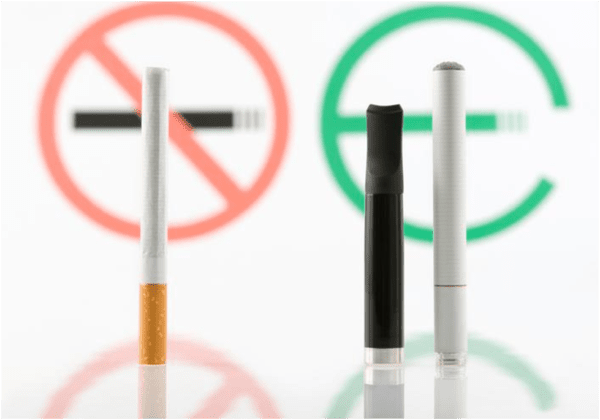If you don’t take the time to look into the subject, it can be easy to believe there isn’t much difference between vaping and smoking when it comes to our health. But that’s simply not true. Even a quick look at the actual facts makes it hard to deny vaping is so much safer than smoking that the two don’t belong in the same sentence. And that’s a shame. Because for as many who’ve been able to rid themselves – mostly or entirely – of the nasty habit of smoking, there are others who continue to smoke because they either don’t know, or don’t believe there’s much (if anything) to be gained by making the switch to vaporizers.

What is the Difference Between Traditional Cigarettes & E-Cigarettes?
There is a world of difference between using a vaporizer and lighting up a cigarette. And for several reasons. Money is an obvious one. A pack-a-day smoker can expect to spend a full 75 percent LESS if cigarettes are replaced with a vaporizer. Vaporizers, also called e-cigs, e-cigarettes, and vapors, are a device which uses heat to turn liquid into vapor while smoking involves the burning of tobacco to create smoke. What do they have in common? Well, both are inhaled. Cigarettes always contains nicotine while e-cigarettes may contain it. How are they different?
| Traditional Cigarettes | E-Cigarettes |
| -When a cigarette is burned 7000 chemicals are released | -Vaporizing doesn’t burn |
| -Contains 600 ingredients, approximately 100 of which are carcinogens | -E-liquid contains 3 food grade ingredient (Flavoring, Vegetable Glycerin, Propylene Glycol) |
| -Always contains nicotine | -Nicotine is Optional |
| -Proven to cause life threatening diseases (Lung & Throat Cancer) | -Studies show little to no harm to your body |
| -Produces nasty smoke smell that lingers | -Produces vapor that dissipates quickly and smells nice |
Critics are fond of pointing out that propylene glycol is found in antifreeze. And it is true – but it’s also found in a variety of foods (soft drinks and ice cream are two examples) as well as products like toothpaste, skin moisturizer, and many injectable medications. The truth? The amount of propylene glycol found in e-liquids is not even close to toxic. As for vegetable glycerin, it is what its name suggests; a liquid extracted from vegetables.

Nicotine is Not the Villain
The Most popular argument used to promote the false narrative that vaporizers are dangerous is the fact that it may contain nicotine. This subject opens a whole can of worms. Aside from the fact that you can vape without using nicotine at all – and many vapers either start out with, or reduce to, low or zero-levels of nicotine in their e-liquid – a lot of disinformation exists concerning nicotine. For starters, it doesn’t take very long to get out of your system – anywhere from 3 days to, at the VERY longest, 3 months. This might initially come as a surprise, ask any serious smoker who quit or tried to quit, whether the craving of nicotine was the biggest obstacle to success. You’ll almost certainly get a resounding “NO!” There’s no question that nicotine is highly addictive, and the cravings are strong when it’s taken away, but they don’t last. It’s the psychological addiction that makes the smoking habit so hard to walk away from permanently. The real dangers associated with smoking cigarettes comes from the tar and all the chemicals it contains, including NNAL – a chemical strongly associated with lung cancer which is found only in the tobacco plant. None of these are found in vaping devices. When you get down to it, the only thing cigarettes and e-cigarettes have in common are the (possible but not required) presence of nicotine, the word “cigarette” and the satisfaction they both provide (something well-understood by any smoker). Further, the actual dangers linked to nicotine are not even close to as bad as we’re led to believe. It’s not highly publicized but the fact is, there is no evidence which links nicotine to cancer. And when you’ve recovered from THAT piece of information which the tobacco industry would rather you not know, there’s data to suggest that nicotine is actually beneficial in the treatment of Alzheimer’s and a few other neurological diseases. Despite these rarely mentioned but verifiable facts about nicotine, e-cigarette products are currently grouped with tobacco products. In 2016, the Canadian Government changed ‘The Tobacco Act’ to ‘The Tobacco and Vaping Products Act’. The various provincial laws in place emerge from this federal act. Perhaps this new industry played into the hands of the tobacco industry and governments everywhere by coining the phrases ‘electronic cigarette’ and ‘e-cigs’ in the terminology used to describe vaping. But it’s easy to see WHY it was chosen. Including the word ‘cigarette’ makes the connection between analogue and electronic cigarettes clear and lets smokers know that there exists a product which actually and effectively simulates the sensation of smoking. It certainly made sense in the early days when no one knew what vaping was. And despite its problems, the use of the word cigarette is powerful. It helps to ease the (already remarkably painless) transition from an extremely dangerous activity to a relatively safe one.

Sixteen Thousand People Die Every Day from Smoking Related Diseases
So why is it that so many people believe there’s little or no difference between smoking and vaping? Where does this false narrative originate? If you look for the truth (and it’s there for the finding), a compelling argument can be made that we have the government and mainstream media, as well as the tobacco and pharmaceutical industries to thank for this misrepresentation of facts; both in Canada and the rest of the world. And when you look in REAL terms at the harm done to people who smoke, it really hits home how important it is to correct this possibly deliberately misleading information about vaporizers. The statistics don’t like, 100 Canadians die EVERY DAY from tobacco related diseases. Globally, that number is more than 16 THOUSAND every day and that number is expected to rise. On the other hand, there is very little factual evidence to support the argument that the act of vaping is particularly harmful. There’s an article in the Huffington Post that makes this point in a powerful way. There is also countless anecdotal evidence outlining the felt-improvements in the health of former smokers who traded in cigarettes for e-cigarettes. Despite the fact that the newness of vaporizers means there’s no long term data available as there is with cigarettes, my money’s on the vaporizers.
While two-thirds of smokers can expect to die as a direct result of smoking cigarettes, there is simply no evidence to make this argument about vaping. It isn’t a tobacco product and doesn’t belong in the same category. Because there is no doubt that when contrasting cigarettes with vaporizers, vaporizers are safe. If you only read one other article to confirm this for yourself, here’s a good one: http://www.churnmag.com/news/vaping-could-save-lives-per-expert/
Vaping is a Game Changer
Vaping isn’t as smart as just breathing air. There’s no question about that. But every indication is that it does very little (if any) harm. And it saves lives. We won’t move forward by fighting the system, but it’s critical for the vaping community to stand behind a product which actually provides a provable health benefit for smokers, their families (pets of course) and the place we call home – the earth. Some of the legislation makes good sense. And since we pay them, what’s wrong with the idea of being willing to pay taxes on vaporizers since they ARE being legislated? It’s almost certainly not going to fully replace the taxes lost on tobacco sales but the difference in income for the Canadian government will be more than realized by the knock-on reduction in health care costs associated with smoking related diseases. If the rules makes sense (children, for example, shouldn’t be anywhere near them) and good etiquette is observed, vaping needs to be welcomed and supported as the life-changer it is.

Opening up The Dialogue
It’s impossible to argue that the safest thing one can do is just breathe. And in a perfect world, smokers everywhere would just stop. Well, this isn’t a perfect world and few smokers would disagree with the often-stated remark that it’s easier to quit hard drugs than it is to stop lighting up. We cannot allow fear-mongering to undercut the fact that this statement has been turned on its head because of e-cigarettes. Just ask any smoker who’s tried to quit. We must ensure the dialogue about vaping continues and that the regulations in place reflect what’s fair. Vaping is still in the early stages compared to smoking and there’s every reason to be proactive when it comes to legislation – which is here to stay, and actually helpful if done equitably. Every vaper and vape shop is part of a community that should be allowed to grow. And having a positive attitude about the benefits of vaporizers as well as talking about the facts whenever there’s a good opening to do so, can only help.
To Vape or Not to Vape
Anyone who tries to tell you that you’re better off vaping than breathing air is lying to you. But by the same token, if you want to be absolutely safe don’t drink water (fluoride), don’t eat (chemicals), don’t brush your teeth (fluoride, propylene glycol). In fact, don’t go out at all – the dangers are too many to count. Well, don’t stay in either (gas leaks, carbon monoxide poisoning, etc.). Living, after all, is a fatal activity. And although vaping doesn’t change that fact, it sure helps smokers slow down the inevitability of it.
Cheryl Tulley:
After a successful career in the financial industry which spanned more than 25 years, Cheryl Tulley turned to her first love and is now a writer and copy-editor. She studied English as well as philosophy at university and received both her securities’ and stockbroker’s licenses while working in finance. In addition to writing articles on a variety of subjects, she copy-edits both undergraduate papers and theses for university students. Cheryl is currently writing her first book
 Gearfuse Technology, Science, Culture & More
Gearfuse Technology, Science, Culture & More


